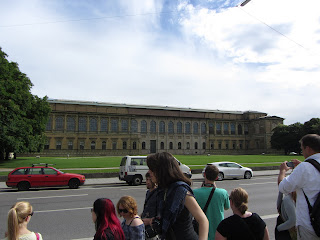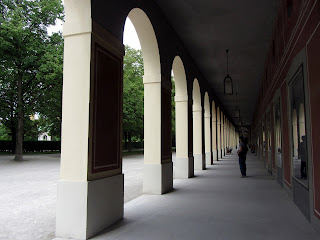Here's just a quick update of our first few lectures in Munich! Classes have officially begun, so for the next five weeks I will likely be writing about the architectural development of a few major European cities, along with photographic art that will hopefully capture the spirit of these places. There are a few days where we don't meet for class, which I intend to use to further explore the architectural fabric of Europe, so perhaps more of a mish-mash of postings can be expected to follow (: As for now, here is a small visual representation of my first two history classes in Munich, which occur mainly along the Ringstrasse and the center of town.
My first impression of Munich formally begins in a square just outside the ring that encompasses downtown Munich. The square is called Königsplatz, and houses three buildings which form a quadrant around an open space. The building pictured above is called the Glyptothek, and its reason for existence falls on the shoulders of King Ludwig, who required a place to house art and sculptures. The Glyptothek was designed by Leo Von Klenze (a famous architect of the 19th century), and is an archetype of the Neo-classical style. You can tell by the columns, open portico, and pediment that there are clear influences from classical Greek and Roman architecture, and the creepy golden statue of Athena in the front and center is another good clue too.
Adjacent to the Glyptothek is a similar building that I admittedly don't know much about, except for its importance as a visual terminice of a main road that approaches Königsplatz. This is one of the reasons that I really appreciate Munich--the city was clearly designed to give precedence to axis and views, both of which work together to create some really stunning experiences.
Across from the Glyptothek is again a very similar building architecturally, which works to mirror the symmetry and ordered geometry that is so traditional of classic Roman and Greek architecture and clearly present within the square. I find this building's role to be the most reserved of the three.
Our next stop occurred briefly at the State Museum of Egyptian Art (or the Staatliches Museum Ägyptischer Kunst, if you're fluent in German) which is particularly interesting since it is the only building solely devoted to the display of Egyptian Art. I really liked its response to the precedent of Egyptian building traditions, like the underground museum which is reminiscent of Egyptian tombs.
Here's a photo of the stairs leading to the entrance underground.
A peculiar statue in front of the museum.
The building across the street sports a much different architectural style.
An obelisk that again serves as a visual marker for travelers along the main city roads. It was a good pick for the space too: since it is located at an intersection, it allows a person to see around it from any angle, denoting both the continuity and further addressing the importance of the main road.
Here's a view from the obelisk, looking back toward one of the streets from which we came.
Just another neat door I passed by!
Sort of tucked away in a small corner park bordered with trees, there's a modest monument attributed to the victims of National Socialism. As it was explained to our class, the monument is controversial for its reserved nature, which apparently is often passed by without the realization that it commemorates anything at all. I personally appreciate the metaphor of the sculpture: the base is oppressive and heavy, and consumes most of the monument. On top rests a cage that holds a consistent flame, symbolizing a hope that burns despite its imprisoned nature.
This is a statue of Maximilian, who was an influential political ruler of Bavaria. His family held the reigns of power successively for a handful of generations, so there are a lot of streets and squares attributed to Maximilian. This is also largely in part of the family's goal to build up the city of Munich so that it could become worthy of being deemed the Country's capital.
We were lucky enough to have such beautiful weather and a blue sky for our walking tour!
This is Feldherrnhalle, or the Field Marshals' Hall, which is another monument located toward the end of Ludwigstrasse. It commemorates the four state policeman who died the night that a group of Nazis rallied in the square unauthorized. The police force attacked the Nazis after they refused to obey orders, and open fire ensued and killed members from both sides. One such member was Hermann Goring, who founded the gestapo.
This is my attempt to capture the cobblestone, which is often used in Europe in place of pavement or something of the like. The cobblestone here is beautifully laid in ongoing patterns, but is sometimes bothersome to walk on.
This is the statue located in the center of the monument.
This arch separates the main road and the pedestrian square from the garden that lies beyond
Here is a pretty arcade that makes up the entrance to the Hofgarten, which is another picturesque park in Munich. There was another class touring the Hofgarten with us that is pictured in the background, although they were from elementary school (:
After entering the garden, to the left lies an ordered network of paths that lead to gorgeous views of fountains, gardens, statues, and just general places of repose. This is what it looks like in plan view:
The small pavilion in the middle is really striking. I don't know if it's because of the lined paths, the flowers that surround it, or the pretty green-blue dome, but it was pleasant to see in the garden.
Inside the pavilion, you can see how the paths begin to line up with the significant architectural marks of the city, or smaller artifacts of the gardens.
In between the arches, small fountains adorned with fish are present.
Perhaps the grass is greener on the other side? Seriously, Germany has some really beautiful green parks!
Further down the park is an old building that was bombed in the war, but later reconstructed with clearly modern materials. This caused some controversy, as it was not agreed upon in the first place as to whether the building should be restored at all. It's the Bavarian State Chancellery, and formerly housed an Army museum.
This is another monument to commemorate fallen soldiers. There are steps leading down into it, which seems to mirror again burying traditions.
Inside, there is a large scale statue laying horizontally. The material palette for this project was pretty unique as well. My photos don't quite do it justice.
Our next stop was at the Haus der Kunst Museum, which houses art. It is historically significant since it was controlled by the Nazi party, which used the gallery to showcase what it deemed appropriate art. The second showing controlled by the party was a showcase of what was inappropriate art, which I find slightly comedic in its pure controversy and attempts to objectify something completely subjective. Needless to say, this caused quite a stir among the then modern artists and impressionists who were pushed into new directions because of these two showings.
We also had the opportunity to explore one of the famous universities of Munich. The building in particular which we visited was the Bayerische Staatsbibliothek, although I didn't really see any books. We mostly popped in to look at the architecture! One of the first things I noticed was the lion handrail adornments. There really are a lot of interesting things you find in the architectural details here!
Here's the inside of the building, with beautiful barrel vaults and marble.
Outside was yet another interesting detail attributed to The White Rose Movement, or more specifically, the Scholl Siblings. I found this to be rather interesting since I had just studied the siblings and the movement last semester in my Remembrance of the Holocaust class. Inlaid between the cobblestone on the ground are tiles which have been modified to look like sampling of paper and photographs, which is a reminder of resistance notes scattered at the University by the Scholls. It's another tricky monument, since one could ether easily walk over this without notice or stop in wonder and curiosity to figure out what is being communicated.
The next few photos compile the rest of my class tour photos, for which I am lacking sufficient commentary.
It is popular to see this in Europe: when buildings are under construction, a screen is place to display what the new facade will look like after the project is completed. As a young and visiting architecture student who will not likely be here when construction is finished, I can fully appreciate this gesture.
I don't have an outdoor photo of this church at the moment, but the inside was gorgeous. It is impossible for me to effectively communicate how small it feels to stand among wide pillars supporting such a lifted ceiling.
So a little myth on this mishap of a tile: apparently after the church was constructed, it stood in its heightened state with equally vertical windows, allowing in a fair amount of light into the large space. Upon seeing this, the devil became angered at the span of windows and overall lack of darkness in the church. He stomped down his foot in anger, disfiguring its floor with the permanent mark of his foot.
Even the front door is adorned with intricate detail. All of the old doors in Europe thus far have been something.
Across the church is a small pond with several mushroom-like fountains in them. I found it to be a very peaceful place to sit, especially since it is shaded by several old trees.
All righty, so my very last exploration I want to share today occurred on one of my "free days" when we didn't have history class in the morning. I had seen this stark yellow church earlier in the week, and I was super curious to see the inside, so I made a point to revisit. Turns out it was completely worth it, since the inside is so laden in baroque ornament it was unlike anything I had ever really experienced. It was also almost completely white. You'd never guess considering the exterior!
There also happened to be a yellow door right beside it, and since yellow is my favorite color (and since the door was more reasonably scaled), I took a photo next to it. The yellow shorts were a coincidence, if you'll believe it!































































No comments:
Post a Comment